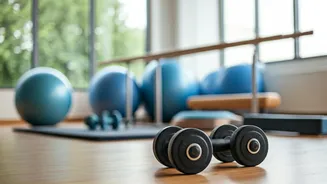Warm-up Essentials
Before diving into any exercise routine, a proper warm-up is crucial. Start with gentle movements that prepare your muscles and joints for activity. A
few minutes of light stretching can significantly enhance your workout's effectiveness and minimize the risk of injury. Try simple exercises like arm circles, leg swings, and neck rotations. These preliminary activities increase blood flow and boost flexibility, setting the stage for more strenuous exercises. Remember to listen to your body and never push yourself beyond your comfort level during the warm-up phase. Tailor the duration to your body's needs, usually around 5-10 minutes. This will help make the subsequent exercises more impactful.
Chair-Based Exercises
Chair exercises are an excellent starting point, especially if you have mobility challenges or fatigue. These exercises offer stability, allowing you to focus on form and movement without the fear of falling. Begin with seated marching: lift your knees one at a time, alternating legs, as if you are marching in place. Then, try arm raises: extend your arms to the sides or overhead while sitting. For a core workout, practice seated twists, turning your torso gently from side to side. Perform each exercise for several repetitions, gradually increasing the number as your strength improves. Maintain good posture throughout to maximize the benefits and minimize strain. Remember to breathe deeply, ensuring oxygen reaches the muscles and tissues, supporting your body through each action.
Balance and Stability
Maintaining balance is often a significant concern for those with Parkinson's. Incorporate exercises designed to improve stability and reduce the risk of falls. Start by standing near a sturdy surface, such as a chair or wall, for support. Practice standing on one leg for a few seconds, switching sides. Next, try walking heel-to-toe, mimicking a tightrope walk. You can progress by attempting to stand with feet close together and slowly lifting one foot off the ground. These exercises can boost your confidence while walking or navigating everyday environments. Gradually increase the duration of each exercise as your balance improves. If possible, consider practicing these exercises in a safe, open space to enhance safety and confidence.
Flexibility and Stretching
Enhance your range of motion and prevent stiffness with regular stretching. These exercises will contribute to a more flexible and comfortable body. Focus on stretching all major muscle groups, including the arms, legs, and back. Try shoulder stretches, reaching your arms across your body and holding. Perform leg stretches like hamstring stretches and calf stretches, holding each for at least 20-30 seconds. Incorporate gentle neck stretches, tilting your head towards your shoulder and rotating it. Flexibility promotes better posture, reduces pain, and improves the overall quality of movement. Breathe deeply while stretching, and be patient with yourself. Remember that consistency is key: making it part of your daily routine will yield the best results.
Coordination Training
Improve your motor skills and cognitive function through coordination exercises. Incorporate movements that require both physical and mental focus. A simple exercise is the arm and leg raises; simultaneously raise your right arm and left leg, then alternate sides. Try finger exercises, like touching each finger to your thumb in sequence. Another effective exercise is to draw figures in the air with your hands, encouraging both brain and body coordination. Practice these exercises regularly, focusing on precision and control. You can slowly increase the difficulty by adding new elements or variations. These kinds of activities stimulate the brain and body and can help improve the coordination that is useful for daily activities. Consider incorporating music or counting while exercising to enhance rhythm and concentration.













